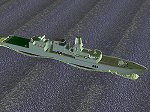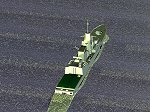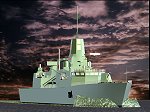|
Characteristics:
Not available.
Ships:
Not available.
Notes:
Since entering service in the early 1970s, the IROQUOIS (280) class
destroyers have provided the Canadian Navy with their only true command
and control capability. More recently, upon being retrofitted with new
weapons and equipment during the TRUMP refits in the early 1990s, these
ships have also provided the Navy's first (and only) area air defence
capability. Starting around 2010, however, the IROQUOIS class
will need to be replaced after close to 40 years of service, and
in fact HMCS HURON has already been paid off.
As a result, the Canadian Government committed to funding a small part
of the development of the Active Phased Array Radar (APAR) system,
which is currently being fitted to new ships of the Dutch and German
navies. Preliminary plans seemed to indicate that this system would be
the basis of new Canadian AAW destroyers, built upon the HALIFAX class
platform, and indeed one shipyard put forth a "Province" class based on
this idea.
More recently, the Navy stated that they intend to replace the
capabilities of the existing IROQUOIS class ships, if not the ships
themselves, suggesting that existing HALIFAX class ships might be
retrofitted with AAW capabilities as part of the FELEX program, or
mid-life refits. The Batch 2 HALIFAX Class (MONTREAL on) were
originally supposed to be built 32' (~10 metres) longer than the first
batch (but were built to the original spec due to budget cuts) so it
was assumed that adding extra length to this hull design for a Mk.41
VLS was not a problem. A new mast would have been required for the
4-facetted APAR system (similar to the new Dutch ships), and room would
have had to be made atop the hangar for the SMART-L installation.This
option, too, has seemingly been eliminated in recent years, presumably
due to the impracticality and costs of retrofitting these capabilities
into existing hulls. It has even been suggested that the HALIFAX class
hull can simply not support the extra topweight of the required
systems.
The currently stated objective is to replace the capabilities of both
the IROQUOIS and HALIFAX classes with a Single Class Surface Combatant
(SCSC) between 2017 and 2025. These ships could be designed from the
ground up to include modular capabilities, in that different weapons
systems and equipment could be swapped in and out to tailor the ships
for their next intended mission.
With the timelines currently proposed, it is likely that the Canadian
Navy will be left without both area air defence and proper command and
control capabilities for at least a decade if not longer. This will
limit the Canadian Navy to having no more than self defence capability
against aircraft and missiles during this time, which is potentially at
odds with the stated desire within the Canadian Forces for large
sealift vessels to carry troops and equipment overseas, and this will
likely increase our reliance on our NATO partners to protect those
assets if they are ever acquired.

Photos:
(click on the thumbnail to load a larger image)
|
Concept photos
|
|
Notes:
|
The following concept artwork
illustrate the possible appearance of the now abandoned idea of
building an area air defence ship around the existing HALIFAX class
platform.
1. New additions:
the Signaal L 3D radar on the hangar, the new mast incorporating the
APAR
3D phased array radar, and the Mk.41 VLS just forward of the bridge.
Image ©
Sandy McClearn.
2. An aft aerial view of the ship. Image © Sandy McClearn.
3. A view of what this type of ship might look like at speed. Image
©
Sandy McClearn.
|
|
1
|
2
|
3
|
4
|

|

|

|
|
|

